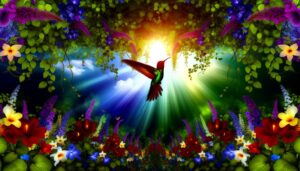What Symbols Are Recognized for New Beginnings?
Symbols of new beginnings abound in various cultures, embodying hope, renewal, and transformation. The lotus flower, revered in Hinduism and Buddhism, flourishes in murky waters, symbolizing purity and spiritual rebirth.
The mythical phoenix, from ancient Egyptian to Chinese lore, epitomizes regeneration through its cycle of death and rebirth. Sunrise signifies daily renewal, while the butterfly's metamorphosis captures profound transformation and change.
Fresh spring blossoms herald resilience and rejuvenation after harsh winters. The new moon, with its cyclic renewal, influences rituals across diverse cultures.
Exploring these symbols reveals their deeper cultural significances and how they universally inspire fresh starts.

Key Takeaways
- The lotus flower symbolizes purity, resilience, and spiritual rebirth.
- The phoenix represents rebirth and renewal through its mythological cycle of death and resurrection.
- Sunrise signifies hope, renewal, and the promise of a fresh start.
- The butterfly embodies transformation, personal growth, and new beginnings.
- Fresh spring blossoms herald the end of winter, symbolizing rejuvenation and hope.
The Lotus Flower

Renowned for its distinctive ability to flourish in murky waters, the lotus flower has long been revered across various cultures as a potent symbol of purity, resilience, and new beginnings.
In Hinduism and Buddhism, the lotus is venerated as a sacred flower, representing spiritual enlightenment and rebirth. Its emergence from muddy waters unscathed embodies the human journey of rising above adversities.
In ancient Egypt, the lotus was associated with the sun and creation, symbolizing rebirth and regeneration. This botanical marvel's ability to bloom unstained in such conditions draws a compelling parallel to human capability to transcend challenges, making it a universal metaphor for new beginnings.
The lotus's cultural significance underscores a profound ethnographic understanding of renewal and perseverance.
The Phoenix
The Phoenix, a mythological bird that cyclically regenerates from its ashes, serves as a profound symbol of rebirth across various cultures. Its narrative of perpetual renewal has transcended ancient mythologies, from Egyptian and Greek traditions to contemporary literature and media.
Examining the Phoenix's cultural significance and modern interpretations reveals a rich tapestry of meanings that continue to inspire and resonate in today's society.
Mythology and Rebirth
Emerging from the annals of ancient mythology, the Phoenix epitomizes the cyclical nature of death and rebirth, symbolizing resilience and the perpetuity of new beginnings across diverse cultures. The mythological narrative of the Phoenix varies, yet consistently illustrates themes of renewal. In Egyptian lore, the Bennu bird, akin to the Phoenix, undergoes self-immolation and resurrection. Greek mythology portrays the Phoenix rising from its ashes, a proof of eternal life. The following table delineates these mythological representations:
| Culture | Phoenix Representation |
|---|---|
| Egyptian | Bennu bird, self-immolation, rebirth |
| Greek | Rises from ashes, everlasting life |
| Chinese | Fenghuang, harmony, renewal |
These mythic tales serve as profound metaphors for transformation and resilience.
Cultural Significance
Traversing beyond mythological lore, the Phoenix's symbolism permeates various cultures, reflecting profound themes of renewal, strength, and the human spirit's indomitable nature.
In ancient Egyptian culture, the Bennu bird, akin to the Phoenix, symbolized the cyclical nature of time and rebirth.
The Greeks and Romans saw the Phoenix as a representation of eternal life and resurrection, mirroring their beliefs in life's cyclical continuum.
In Chinese mythology, the Fenghuang, often conflated with the Phoenix, signifies virtue, grace, and the harmonious balance of yin and yang.
This comparative ethnographic detail underscores the Phoenix's universal resonance, transcending cultural boundaries to embody the quintessential symbol of new beginnings and perpetual transformation across civilizations.
Modern Interpretations
In contemporary society, the Phoenix symbolizes not only personal and collective resilience but also the transformative power inherent in overcoming adversity. This mythical bird, which cyclically regenerates from its ashes, resonates deeply within modern contexts—ranging from individual journeys of recovery to societal rebirths following crises.
Comparative analysis reveals its ubiquity across cultures, from Western literature to Eastern philosophies, each attributing unique layers of meaning. Ethnographically, the Phoenix is invoked in rituals, art, and motivational narratives, representing hope and renewal. Its enduring relevance underscores a universal human aspiration: to rise stronger from trials, embodying the perpetual cycle of death and rebirth.
Consequently, the Phoenix remains a potent emblem of new beginnings in the modern era.
Sunrise

Across cultures and epochs, the emergence of dawn's first light has consistently symbolized renewal and hope, marking the shift from darkness to a fresh start.
This daily phenomenon carries profound significance, drawing parallels to the rebirth myths of various civilizations, much like the Phoenix.
Ethnographic studies reveal that rituals and traditions surrounding sunrise often underscore humanity's intrinsic optimism and enduring belief in new beginnings.
Dawn's First Light
As the horizon slowly brightens, the first light of dawn symbolizes not just the start of a new day, but also the promise of renewal and the endless cycle of beginnings. Across various cultures, dawn embodies a universal metaphor for fresh starts. In Japanese culture, it is celebrated during the New Year as a symbol of hope. Hindu traditions view the first light as divine, marking a time for meditation and spiritual awakening. The ancient Egyptians revered dawn as the rebirth of the sun god Ra, signifying life and energy.
| Culture | Symbolism of Dawn |
|---|---|
| Japanese | Hope and New Year |
| Hindu | Spiritual Awakening |
| Egyptian | Rebirth of Sun God Ra |
| Native American | Renewal and Guidance |
Dawn's first light unites humanity in its shared pursuit of new beginnings.
Renewal and Hope
From the gentle illumination of dawn, the emergence of sunrise heralds a profound sense of renewal and infuses hope into the human spirit.
This daily phenomenon transcends cultures, symbolizing rebirth and the promise of new opportunities.
In various traditions, such as Japan's Shinto rituals, sunrise is venerated as a sacred time for reflection and renewal.
Similarly, ancient Egyptians worshipped Ra, the sun god, associating sunrise with the cycle of life and regeneration.
The symbolism of sunrise is not merely metaphorical but deeply ingrained in the human psyche, offering a tangible representation of hope.
As the world awakens, bathed in the golden hues of morning light, individuals are reminded of the perpetual possibility for growth and transformation.
The Butterfly
Evolving through a remarkable metamorphosis, the butterfly stands as a profound symbol of transformation and rebirth across various cultures and epochs.
In ancient Greek mythology, the butterfly represents the soul's immortality and eternal life.
Indigenous American tribes view it as an emblem of change and joy.
In Japanese culture, it signifies marital bliss and new beginnings.
The butterfly's life cycle—from a humble caterpillar to a splendid winged creature—exemplifies personal growth and resilience.
- Greek mythology: Symbolizes the soul's immortality.
- Indigenous American beliefs: Represents change and joy.
- Japanese culture: Signifies marital bliss and new beginnings.
- Life cycle: Illustrates transformation and personal growth.
- Resilience: Embodies overcoming adversity and emerging stronger.
This rich symbolism makes the butterfly a quintessential icon of new beginnings.
Fresh Spring Blossoms

Why do fresh spring blossoms universally captivate the human spirit, symbolizing renewal and the cyclical nature of life?
Historically, spring blossoms have heralded the end of harsh winters, signifying rebirth.
In Japan, cherry blossoms (sakura) are celebrated during Hanami, signifying ephemeral beauty and the fleeting nature of life.
Conversely, in Western cultures, daffodils and tulips mark the arrival of spring, symbolizing hope and new beginnings.
The recurring appearance of these blossoms serves as a poignant reminder of life's resilience and the promise of rejuvenation.
Ethnographically, diverse cultures have revered spring blooms for their vivid colors and transient beauty, which reflect the universal human experience of renewal and the eternal cycle of death and rebirth.
The New Moon
Often regarded as a celestial symbol of fresh starts and potential, the new moon, in various cultures, represents the beginning of a new cycle, embodying themes of renewal and introspection. This phase of the lunar cycle is often associated with setting intentions and planting seeds for future growth. Ethnographic studies reveal diverse cultural practices linked to the new moon:
- Hinduism: Observances like Amavasya, a time for ancestor worship and new ventures.
- Chinese Culture: The lunar new year begins with the new moon, signaling rebirth.
- Native American Traditions: Rituals and ceremonies to honor new beginnings.
- Western Astrology: A period for goal-setting and personal development.
- Islamic Calendar: The new moon marks the start of months, including Ramadan and Eid.
These practices underscore the new moon's universal resonance as a symbol of new beginnings.
Conclusion
In the tapestry of cultural symbols, the lotus flower, the phoenix, sunrise, the butterfly, fresh spring blossoms, and the new moon each represent new beginnings in unique ways.
From the rebirth of the phoenix in ancient mythology to the transformative journey of the butterfly, how do these symbols encapsulate the essence of renewal across diverse societies?
These emblems not only illustrate cyclical renewal but also underscore the universal human aspiration for growth and transformation.




